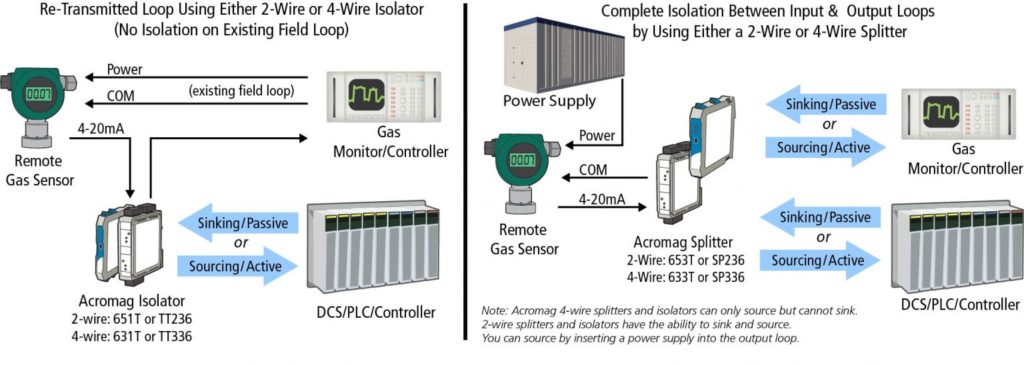Understanding the Problem: Why Re-Transmit & Isolate 4-20mA Signals?
In many industrial applications, 3-wire gas detection sensors monitor hazardous gases and transmit 4-20mA signals directly to a remote gas monitor or controller. However, there are situations where the signal must be sent to multiple destinations. This can be achieved using two methods:
- Signal retransmission: Sending the existing signal to additional locations.
- Signal isolation: Preventing electrical interference by isolating the signal before distributing it to multiple locations.
Why Isolating 4-20mA Signals is Important
- Prevents ground loops that can distort sensor readings.
- Enhances signal integrity when transmitting data over long distances.
- Improves system safety in hazardous environments.
- Enables multiple signal outputs without signal degradation.
Best Methods to Re-Transmit and Isolate Signals
Option 1: Using a Signal Isolator
A signal isolator takes a 4-20mA input signal and provides an isolated 4-20mA output, ensuring that connected devices do not interfere with each other.
Option 2: Using a Signal Splitter
A signal splitter takes one 4-20mA input and provides two isolated 4-20mA outputs, allowing the signal to be sent to multiple locations.
System Requirements for Re-Transmitting and Isolating 4-20mA Signals
For a 3-wire gas detection sensor, the 4-20mA signal transmission works as follows:
- The sensor and receiver share a ground connection with power.
- A third wire connects to power outside the current loop.
To re-transmit and isolate the signal, use one of the following options:
- 2-wire or 4-wire isolator to re-transmit and isolate the loop to a single location.
- 2-wire or 4-wire splitter to send the loop to two separate locations while maintaining isolation on all three loops.
The Best Acromag Signal Isolators and Splitters for This Application
2-Wire and 4-Wire Isolators: Features and Benefits
Acromag signal isolators take a 4-20mA field input and provide an isolated 4-20mA output. Each channel operates independently, ensuring no interaction between signals. Perfect for Industrial Signal conditioning.
✅ Field-adjustable 600T Series isolators with zero and span trim pots for precise tuning. ✅ Pre-calibrated TT Series isolators for plug-and-play use. ✅ 1500V isolation to protect against electrical faults and ground loops. ✅ Factory-calibrated models for quick installation. ✅ Easy recalibration using Acromag’s Windows Software or Agility Mobile App.
2-Wire and 4-Wire Splitters: Features and Benefits
Acromag signal splitters for industrial automation allow a single 4-20mA signal to be duplicated and sent to two independent destinations.
✅ Maintains electrical isolation across all signal outputs. ✅ No signal degradation even when transmitting to multiple devices. ✅ UL/cUL Class 1 Division 2 safety rating for hazardous areas. ✅ Reliable performance in industrial applications.
Recommended Acromag Products
| Product Type | Model |
|---|---|
| 2-Wire Isolators | 651T-0600, TT236-0600 |
| 4-Wire Isolators | 631T-0500 (DC Power), 631T-0100 (AC Power), TT336-0700 |
| 2-Wire Splitters | 653T-0600, SP236-06600 |
| 4-Wire Splitters | 633T-0500 (DC Power), 633T-0100 (AC Power), SP336-0700 |
How to Properly Install Acromag Isolators and Splitters
- Follow proper wiring practices as detailed in the Acromag user manual.
- Ensure earth grounding is correctly connected to minimize electrical noise.
- Use high-quality cables for accurate and stable 4-20mA signal transmission.
- Calibrate the isolators using the zero and span trim pots or Acromag’s calibration software.
- Test the output to confirm proper signal retransmission and isolation.
Why Choose Acromag for 4-20mA Signal Isolation?
Acromag designs isolators and splitters for rugged industrial applications, making them ideal for gas detection sensors in hazardous environments.
- ✅ UL/cUL Class 1 Division 2 rated for safety.
- ✅ High-performance signal accuracy up to ±0.05%.
- ✅ Reliable operation in harsh conditions (temperature, humidity, and interference-resistant).
- ✅ Easy integration with existing systems due to flexible power and mounting options.
Frequently Asked Questions (FAQ)
Q: Why do I need to isolate a 4-20mA signal?
A: Isolation prevents ground loops, protects against electrical interference, and ensures reliable signal transmission across multiple devices.
Q: What is the difference between a 2-wire and a 4-wire isolator?
A: 2-wire isolators are loop-powered. 4-wire isolators require an external power source. However, provide better isolation and stronger sensor signal transmission.
Q: How do I choose between an isolator and a splitter?
A: Use an isolator when you need to protect a signal from interference and a splitter when you need to send a signal to multiple devices while maintaining isolation.
Get Expert Assistance
👉 Need help selecting the right signal isolator or splitter? Contact Metromatics today for expert advice and solutions tailored to your application
This application blog on how to re-transmit and isolate 4-20mA signals from remotely mounted 3-Wire Gas Detection Sensors is provided by our friends at Acromag. To see the original blog, click here.
